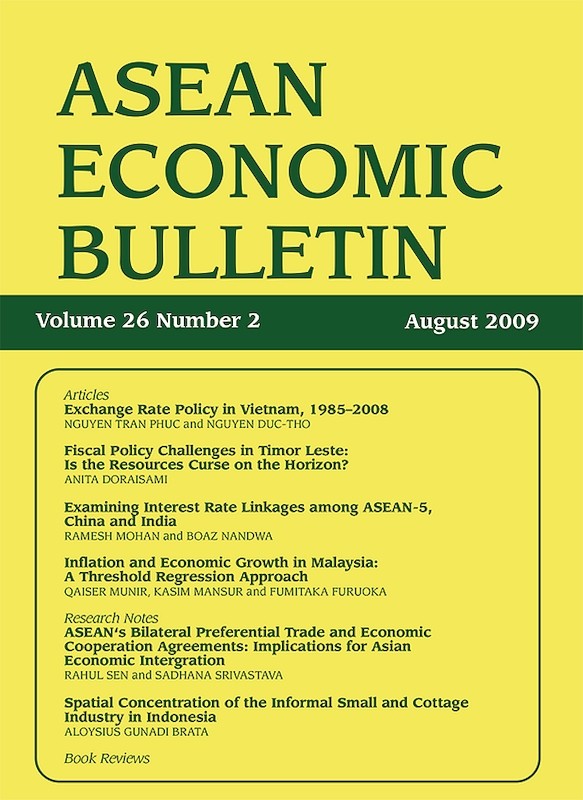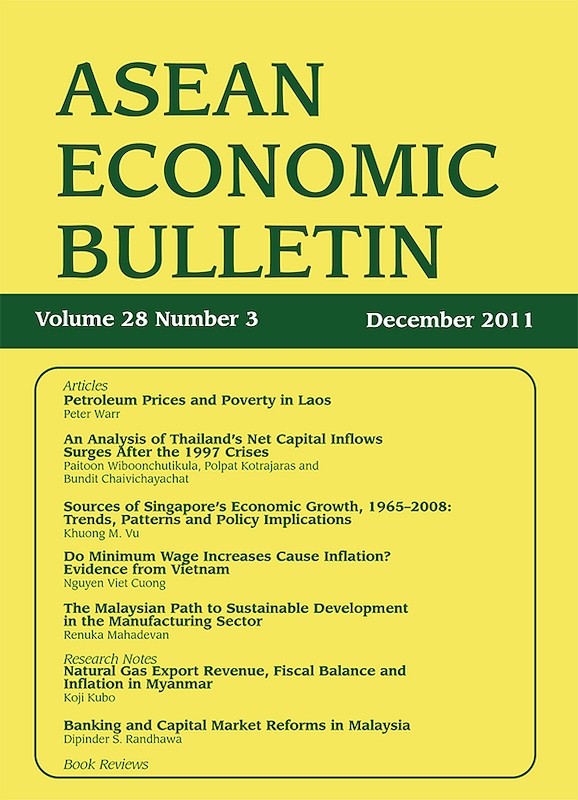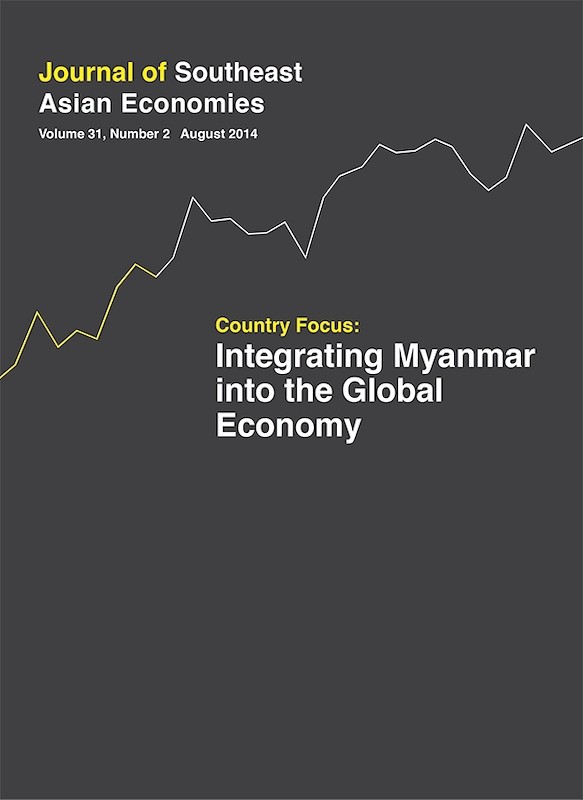ASEAN Economic Bulletin Vol. 26/2 (Aug 2009)

Date of publication:
August 2009
Publisher:
Institute of Southeast Asian Studies
Number of pages:
101
Code:
AE26/2
Contents
-
ASEAN Economic Bulletin Vol. 26/2 (Aug 2009)
[Whole Publication] -
Preliminary pages
- ARTICLES
-
Exchange Rate Policy in Vietnam, 1985-2008, by Nguyen Tran Phuc, Nguyen Duc-Tho, authors see abstractIn this paper we provide a review and synthesis of some of the available information and data regarding Vietnam's exchange rate regime, as well as an analysis of whether, and to what extent, the conduct of exchange rate policy has been consistent with a number of possible key policy objectives. To facilitate the analysis, annual and monthly data are compiled for both the nominal and real effective exchange rates (NEER and REER). The analysis suggests that the authorities have tended to place special emphasis on maintaining stability in the nominal, bilateral VND/USD exchange rate. As a consequence, there have been periods when the REER appreciated, indicating losses in international competitiveness. The official exchange rate's stability has also acted as a retardant in the development of the country's foreign exchange market. It appears that this stability has been neither necessary nor sufficient for inflation control.
-
Fiscal Policy Challenges in Timor Leste: Is the Resources Curse on the Horizon?, by Anita Doraisami, author see abstractTimor Leste is one of the poorest countries in the world, beset by problems of high rates of growth of population, widespread poverty, and a history of civil disturbances. This paper describes the macroeconomic situation and performance of Timor Leste since its independence in 2002. The focus of this paper is on Timor Leste's use of its oil resources to finance its development. While the opportunity to channel oil revenues for employment generation and economic development are cause for optimism in this country, there is also the danger of a "resource curse" that has plagued several oil-rich countries in the past. Will the current fiscal policy stance of the government lead to sustainable development or would it lead the economy to succumbing to the resource curse? Timor Leste cherishes ambitions of becoming a more prosperous country in the region however, several challenges and constraints remain.
-
Examining Interest Rate Linkages among ASEAN-5, China and India, by Ramesh Mohan, Boaz Nandwa, authors see abstractInterest rates play an important role, not only in attracting capital inflow, but also in macroeconomic stabilization and determining asset prices. Given the interdependent nature of member countries of the Association of Southeast Asian Nations (ASEAN), it is crucial to examine whether there is any evidence of co-movement of short-term domestic interest rates within these economies. In addition, because of their significant economic influence in the region, we explore the Granger causality with China and India in determining their impact on interest rate movement in ASEAN-5 economies. We find evidence of co-integration; there is co-movement among the ASEAN interest rates. Further, based on the causality test, we find that China exerts more influence on the direction of the interest rates in the region.
-
Inflation and Economic Growth in Malaysia: A Threshold Regression Approach, by Qaiser Munir, Kasim Mansur, Fumitaka Furuoka, authors see abstractThis paper examines the issue of the existence of threshold effects in the relationship between inflation rate and growth rate of GDP in the context of Malaysia, using new endogenous threshold auto-regressive (TAR) models proposed by Hansen (2000) for estimation and inference. The empirical analysis uses annual data from Malaysia for the period 19702005. A specific question addressed in this study was: What is the threshold inflation rate for Malaysia? The findings clearly suggest that one inflation threshold value (i.e., structural break point) exists for Malaysia; and this implies a non-linear relationship between inflation and growth. The estimated threshold regression model suggests 3.89 per cent as the threshold value of inflation rate above which inflation significantly retards growth rate of GDP. In addition, below the threshold level, there is a statistically significant positive relationship between inflation rate and growth. If Bank Negara (Central Bank of Malaysia) pays more attention to the inflation phenomena, then substantial gains can be achieved in low-inflation environment while conducting the new monetary policy.
- RESEARCH NOTES
-
ASEANs Bilateral Preferential Trade and Economic Cooperation Agreements: Implications for Asian Economic Integration, by Rahul Sen, Sadhana Srivastava, authors see abstractThe phenomenon of proliferation of preferential trade agreements, bilaterally and regionally, was particularly more pronounced both in the aftermath of the regional financial and economic crisis that affected East Asia in 199798 and in the inability of the WTO to yield any substantial outcome to improve growth prospects of the Asian economies. This paper analyses the implications of ASEANs ongoing FTAs and examines its role in fostering deeper economic integration within ASEAN and in Asia. It analyses the evolution and characteristics of FTA proliferation in ASEAN, identifying major trends. The paper argues that in their present state, if not properly designed and managed, there are valid concerns that these FTAs could end up becoming a stumbling block towards integration efforts. Implementation integrity among FTA members therefore remains a key to its success, and empirical and policy research needs to be much more forthcoming in this area in order to fully understand the economic ramifications of these FTAs.
-
Spatial Concentration of the Informal Small and Cottage Industry in Indonesia, by Aloysius Gunadi Brata, author see abstractThis paper discusses the spatial concentration of the small and cottage industry without legal entity or informal industry in Indonesia in 19982005. The study found provinces in Java consistently show a strong domination in total employment of the informal small and cottage industries. By employing several measures on the employment data, this study found an increase in spatial concentration of the informal small and cottage industry during this period. This paper argues that there are two important explanations regarding the increase in spatial concentration. Both explanations are the impact of economic performance and the impact of high cost of formality. It implies that to decrease spatial concentration there is a need to improve the equality of economic growth across provinces together with an effort to reduce the cost of formality in doing business.
- BOOK REVIEWS
-
BOOK REVIEW: Asian Regional Governance: Crisis and Change, edited by Kanishka Jayasuriya, by Moe Thuzar, author
-
BOOK REVIEW: Asia's New Regionalism, by Ellen Frost, by Lorraine Carlos Salazar, author
-
BOOK REVIEW: Indonesia and ASEAN Free Trade Agreement: Nationalist and Regional Integration Strategy, by Alexander C. Chandra, by Aris Ananta, author
-
BOOK REVIEW: Public Expenditures, Growth, and Poverty: Lessons from Developing Countries, edited by Shenggen Fan, by Robert L Curry, Jr., author






